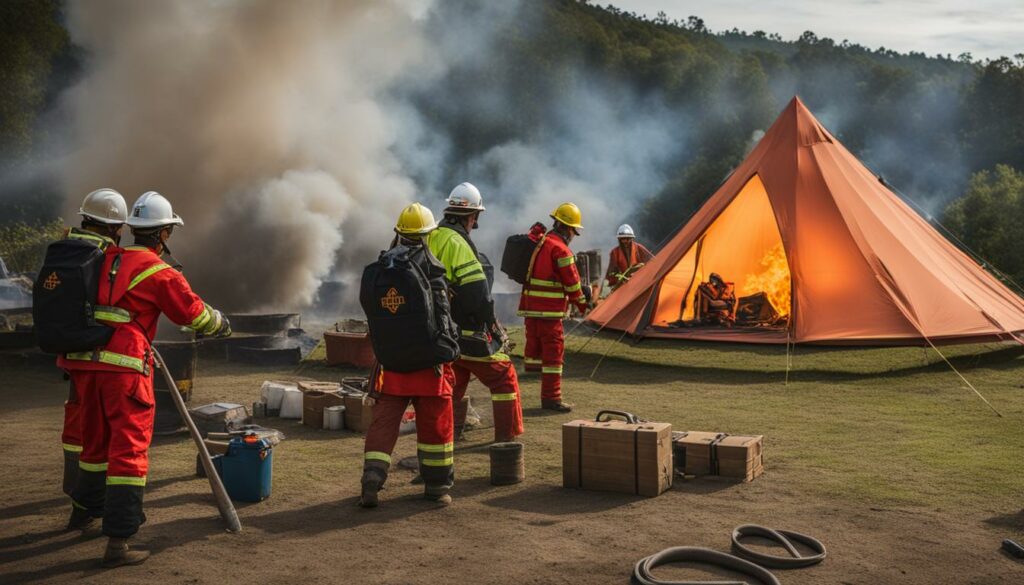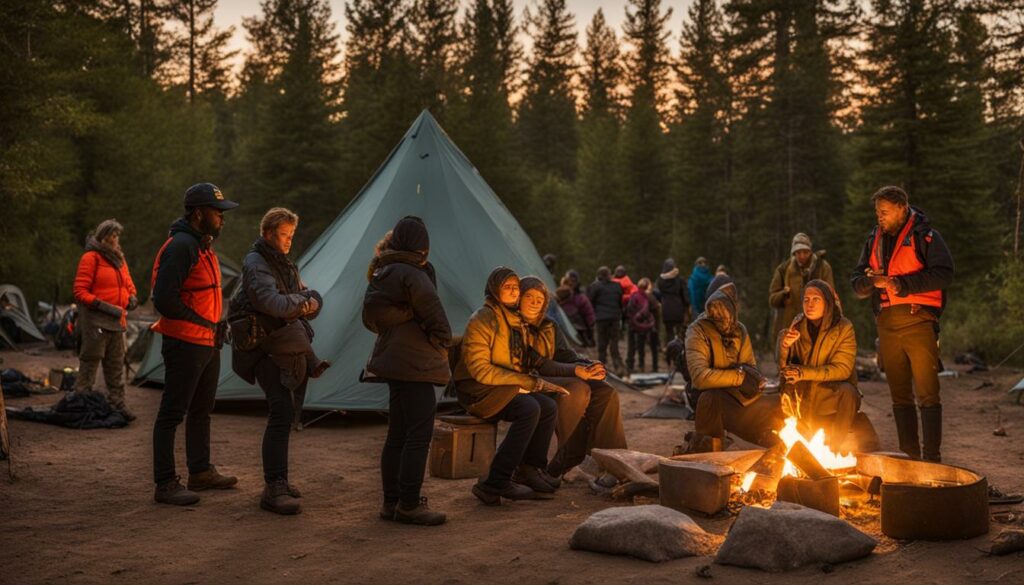Glamping, which stands for glamorous camping, has become an increasingly popular activity in recent years. It combines the beauty and tranquility of nature with the luxury and comfort of high-end resorts. However, the enjoyment of the great outdoors comes with risks, especially during emergencies. That is why it is important for glamping sites to have comprehensive emergency response protocols in place to ensure the safety of their guests.
Glamping emergency procedures should cover a range of potential emergencies, including fires, severe weather, medical emergencies, and even natural disasters. It is not enough to simply have a plan; glamping sites must also train their staff to respond properly in crisis situations. By doing so, they can prevent injuries, mitigate risks, and maintain their reputation as a safe and reliable destination for luxury camping.
Key Takeaways:
- Comprehensive emergency response protocols are essential for glamping sites.
- Emergency procedures should cover a range of potential emergencies.
- Staff training is necessary for effective emergency response.
- Proper emergency planning can prevent injuries and mitigate risks.
- Glamping sites should prioritize safety to maintain their reputation.
Glamping Site Emergency Planning: Key Considerations
Emergency preparedness is critical when it comes to ensuring the safety of luxury campers in glamping sites. Proper planning can help minimize the impact of emergencies and ensure that appropriate measures are in place to manage crises. Here are some key considerations for creating effective emergency plans for glamping sites:
Risk Assessment
The first step in developing an emergency plan for a glamping site is to conduct a thorough risk assessment. This includes identifying potential hazards, evaluating the likelihood of each scenario, and assessing the potential impact. A risk assessment should be conducted regularly, updated as needed, and communicated to all relevant staff members.
Communication Strategies
Effective communication is critical during emergencies. It is essential to have a communication plan in place for both staff and guests. This includes identifying key personnel responsible for communicating during crises, establishing communication protocols, and ensuring that all staff members are trained in these procedures. Having an emergency notification system in place can also help improve communication and response times.
Coordination with Local Emergency Services
It is essential to have a good working relationship with local emergency services such as police, fire, and medical services. Coordination with these services should be included in the emergency plan, and staff members should be aware of available resources in case of an emergency. Regular training and drills with local emergency services can also help improve overall response times.
| Consideration | Description |
|---|---|
| Risk Assessment | Identify hazards, evaluate likelihood, and assess potential impact. |
| Communication Strategies | Establish communication protocols and train staff members, ensure an emergency notification system is in place. |
| Coordination with Local Emergency Services | Establish a good working relationship with local emergency services, include in the emergency plan and conduct regular training and drills. |
By following these key considerations, glamping site operators can ensure they are adequately prepared to manage emergencies effectively. Emergency planning in glamping sites is essential to keep luxury campers safe and secure during their stay.
Glamping Site Evacuation Plans: Ensuring Safety during Emergencies

During emergencies, evacuation plans are critical in ensuring that glamping sites’ campers and staff are safe. An evacuation plan is a comprehensive strategy that outlines the necessary steps to take during an emergency, including the safe exit of people from the site, the designated assembly areas to be used, and the communication channels to be followed.
An effective evacuation plan must be tailored to the site and include clear evacuation routes, emergency services contacts, and established communication channels that staff and campers can use. The evacuation plan should be displayed in site common areas and communicated to all site visitors upon check-in.
In addition to having an evacuation plan, glamping sites should conduct regular drills to ensure that staff and visitors are familiar with the procedures to follow during emergencies. These drills will help identify any potential gaps in the evacuation plan and provide an opportunity to refine it to make it more effective.
Glamping site owners can work with local emergency services to develop comprehensive evacuation plans that consider the surrounding environment, local weather patterns, and any other potential risks. Developing an effective evacuation plan requires collaboration from all stakeholders, including management, staff, and relevant authorities.
Key Components of a Successful Evacuation Plan
| Component | Description |
|---|---|
| Designated Assembly Area | A specific location where all visitors should assemble after evacuating the site and where staff and emergency responders can account for all visitors. |
| Clear Evacuation Routes | Well-marked paths that visitors can follow to exit the site safely. These routes should be the quickest and safest way out of the site and should consider visitors with limited mobility or disabilities. |
| Emergency Services Contacts | Emergency service providers’ phone numbers, including the local fire department, police station, hospital, and ambulance service. |
| Communication Channels | A well-defined communication plan to ensure all visitors and staff members know what is happening and what actions to take during an emergency. |
Implementing effective evacuation plans can save lives and prevent injuries during emergencies. By prioritizing emergency preparedness in luxury camping, glamping sites can create a safe environment for all visitors.
Glamping Emergency Drills: Training Staff for Crisis Situations
Regular drills are an essential part of emergency preparedness in luxury camping. Glamping sites should conduct emergency drills at least twice a year to ensure that staff members are trained to respond quickly and efficiently during a crisis.
During these drills, staff members should practice evacuation procedures, first aid techniques, and communication protocols. By doing so, they can identify any gaps in their emergency plans and address them accordingly. It’s also an opportunity to update staff on any changes to the emergency response protocols.
The Benefits of Glamping Emergency Drills
Conducting regular glamping emergency drills offers several benefits, including:
- Identifying weaknesses in the emergency response plan and addressing them accordingly.
- Ensuring that all staff members are familiar with their roles and responsibilities during an emergency.
- Allowing staff members to practice communication procedures and improve their coordination.
- Boosting staff confidence and reducing the likelihood of panic during a crisis situation.
The Role of Emergency Response Team in Glamping Sites

Having a dedicated emergency response team is crucial for ensuring the safety of luxury campers in glamping sites. The emergency response team is responsible for executing emergency plans and coordinating with local emergency services. In addition, they play a significant role in educating staff members and campers about emergency preparedness in luxury camping.
The team is composed of trained professionals who have the necessary skills and experience to handle different types of emergencies, including natural disasters, medical emergencies, and fires. They work in tandem with on-site staff to ensure prompt and efficient response to emergencies.
Effective communication channels are critical in emergency situations. The emergency response team must have clear communication channels with staff members, campers, and local emergency services to ensure proper coordination and execution of emergency plans.
Furthermore, the emergency response team must conduct regular training programs for staff members to ensure that they are fully prepared to handle emergency situations. This includes training on basic first aid, evacuation drills, and the use of emergency equipment.
Glamping First Aid Kits: Equipping Sites for Medical Emergencies
Glamping sites offer a luxurious camping experience, but emergencies can happen anytime. Well-equipped first aid kits in such sites are critical to ensure the safety and well-being of campers. A standard first aid kit should have items like bandages, antiseptic wipes, pain relief medication, and sterile gauze. However, in luxury camping, the risks may be higher and require additional supplies like instant ice packs, emergency blankets, and disposable gloves. It’s essential to inspect and restock the first aid kit regularly and train the staff to use it effectively.
A good idea is to customize the first aid kit according to the site’s location. For example, if the site is near a lake, it’s crucial to include water-resistant supplies like floatable braces and waterproof plasters. If the site is in an area prone to insect bites, anti-allergy medication and sting relief sprays should be a part of the kit.
Moreover, the first aid kit should be easily accessible and visible in case of an emergency. Glamping sites should also post clear signs and directions leading to the first aid kit location. Staff should receive training to handle medical emergencies and know when to call for additional help or contact the appropriate emergency services.
By being proactive and prepared, glamping sites can equip themselves to handle medical emergencies and ensure the safety and well-being of their campers.
Glamping Site Safety Regulations: Compliance and Best Practices

Glamping sites must comply with safety regulations to ensure that luxury campers are protected during emergencies. By adhering to these regulations, glamping sites can minimize risks and prevent accidents from occurring. Compliance with safety regulations is particularly crucial during natural disasters, which can be life-threatening if glamping sites fail to adhere to safety protocols.
There are several regulatory bodies that enforce safety standards and guidelines for glamping sites. One such regulatory body is the International Fire Code (IFC), which provides specific guidelines for fire safety in glamping sites. The IFC recommends the installation of smoke detectors, fire extinguishers, and fire suppression systems to ensure that the site is well-equipped to handle fires.
Best Practices for Glamping Site Safety
In addition to regulatory compliance, glamping sites should also implement best practices for safety. These practices include conducting regular safety audits, ensuring site cleanliness and maintenance, and training staff members on emergency procedures. It is also important to have an emergency response team in place that is trained to react quickly to emergencies and communicate effectively with local emergency services.
Safety Regulations for Glamping Sites
| Area of Concern | Regulatory Body | Regulations |
|---|---|---|
| Fire Safety | International Fire Code | Smoke detectors, fire extinguishers, fire suppression systems |
| Structural Integrity | National Fire Protection Association | Regular inspections, compliance with building codes |
| Food Safety | Food and Drug Administration | Proper storage, preparation, and handling of food |
| Water Safety | Environmental Protection Agency | Regular testing, treatment, and maintenance of water systems |
By following safety regulations and implementing best practices, glamping sites can ensure that luxury campers have a safe and enjoyable experience. It is important to prioritize safety and emergency preparedness to minimize the risks of accidents or emergencies.
Preparing for Natural Disasters in Glamping Sites
Glamping sites are not immune to natural disasters, and preparing for potential emergencies caused by extreme weather events is essential for ensuring the safety of luxury campers. In this section, we explore some strategies for mitigating risks and preparing for natural disasters in glamping sites.
Assessing Risks
Before an emergency occurs, it’s crucial to assess the potential risks and hazards in the area. This includes researching the likelihood of natural disasters such as hurricanes, tornadoes, wildfires, and floods, as well as any seasonal changes that may affect the site’s surroundings.
Creating an Emergency Plan
Once you have assessed the risks around your glamping site, it’s important to have a clear action plan in place to respond to emergencies. This plan should include designated evacuation routes, assembly areas, communication protocols, and instructions for staff members on how to assist guests during an emergency.
Stocking Emergency Supplies
It’s crucial to have well-stocked emergency supplies on hand in case of a natural disaster. This includes non-perishable food items, water, first aid kits, flashlights, and extra batteries. Ensure that all supplies are stored in a secure location that’s easily accessible in an emergency.
Partnering with Local Emergency Services
Local emergency services can be invaluable resources for glamping sites in case of a natural disaster. It’s important to establish a relationship with these services and coordinate with them for emergency management. Make sure that your emergency plan includes contact information for the local authorities, and make them aware of your glamping site’s location and potential risks in the area.
“Natural disasters can happen anywhere, at any time. It’s important for glamping sites to be adequately prepared to ensure the safety of their guests.”
Communication Systems in Glamping Sites: Ensuring Effective Messaging

Effective communication is essential during emergencies in glamping sites. With reliable communication systems in place, the emergency response team can coordinate and respond swiftly to any crisis. Various communication channels can be utilized, such as two-way radios, emergency notification systems, and cellular phones. It is imperative to ensure that all communication devices are regularly tested and updated to guarantee their functionality when needed.
In addition, having clear communication protocols is vital to avoid confusion and misunderstandings. Communication plans should outline the flow of information, designated communication channels, and the roles and responsibilities of team members during an emergency. Staff should be trained on the communication protocols and be familiar with all communication devices used in the site.
Two-way Radios
Two-way radios are useful in environments where cellular phone signals are weak or unreliable. They allow clear and uninterrupted communication between staff members and the emergency response team. It is advised to select radios with a range that covers the entire glamping site and have backup batteries as a power source.
Emergency Notification Systems
Emergency notification systems are becoming increasingly popular in glamping sites. These systems allow for quick and effective communication with all luxury campers in the event of an emergency. The systems can send messages via text, email, or voice calls and can also provide instructions on necessary actions such as evacuation.
Cellular Phones
Cellular phones are essential communication devices in glamping sites. They provide quick and easy communication between staff members, the emergency response team, and external emergency services. It is recommended to have a designated cellular phone for emergencies and ensure that it is fully charged and has sufficient signal strength.
Overall, reliable communication systems can make a crucial difference in emergency situations in glamping sites. By using adequate communication channels and having clear communication protocols, site staff can deal with emergencies efficiently and effectively, ensuring the safety of luxury campers.
Crisis Management in Glamping Sites: A Proactive Approach
Having emergency procedures and safety protocols in place is crucial for ensuring the safety of luxury campers. However, being proactive in crisis management is equally important. Continuous monitoring and regular updates must be made to establish a comprehensive approach to preparedness.
Glamping site managers must carefully plan and practice drills to ensure staff is well-trained and able to respond quickly during emergency situations. This not only ensures the safety of guests but can also prevent further damage or injury.
Regular audits should be conducted to ensure that the site’s emergency response plans are up-to-date, in compliance with regulations, and meeting industry best practices. In case of any changes, these plans must be updated, and staff must be informed accordingly. This proactive approach can make a significant difference in response and recovery.
Key Elements of Proactive Crisis Management in Glamping Sites
| Elements | Description |
|---|---|
| Regular staff training | Conduct regular training to ensure staff is well-equipped to handle emergency situations. |
| Regular drills and simulations | Practice emergency response plans at least twice a year to keep staff prepared and improve response time. |
| Continuous monitoring | Implement a monitoring system to detect potential risks and prevent them from becoming emergencies. |
| Regular audits and updates | Conduct regular audits to ensure emergency plans are up-to-date and in compliance with regulations and industry best practices. |
By taking a proactive approach to crisis management, glamping sites can ensure a safe and enjoyable luxury camping experience for guests while mitigating risks and improving response and recovery efforts.
Conclusion
Emergency response protocols in glamping sites play a vital role in ensuring the safety of luxury campers during emergencies. From effective planning and evacuation procedures to trained staff and communication systems, glamping sites must have comprehensive protocols in place to mitigate risks and respond swiftly to crises. Adhering to safety regulations and industry standards, monitoring and updating plans regularly, and conducting regular emergency drills can help glamping sites maintain preparedness. By taking a proactive approach to crisis management, glamping sites can prioritize the safety and well-being of their guests and staff.
FAQ
What are emergency response protocols for glamping sites?
Emergency response protocols for glamping sites are comprehensive procedures and protocols designed to ensure the safety of luxury campers during emergencies. These protocols include risk assessment, communication strategies, evacuation plans, emergency drills, first aid kits, and compliance with safety regulations.
What key considerations should be included in glamping site emergency planning?
Glamping site emergency planning should include a thorough risk assessment, clear communication strategies, coordination with local emergency services, and designation of assembly areas and evacuation routes. It should also consider the specific needs of luxury campers and any potential challenges posed by the site’s location.
How can glamping sites ensure safety during emergencies through evacuation plans?
Glamping sites can ensure safety during emergencies by developing effective evacuation plans. These plans should include designated assembly areas, clear evacuation routes, and communication protocols. Regular drills and training for staff members are also essential to ensure the efficient execution of the evacuation plan.
Why is conducting glamping emergency drills important?
Conducting regular emergency drills in glamping sites is crucial for training staff members to respond swiftly and effectively during crisis situations. These drills help familiarize staff with emergency protocols, identify any areas that need improvement, and ensure that everyone is prepared to handle emergencies, resulting in better safety outcomes.
What is the role of an emergency response team in glamping sites?
An emergency response team plays a vital role in glamping sites by coordinating emergency responses, ensuring the safety of luxury campers, and providing immediate assistance during crises. This team is responsible for implementing emergency protocols, communicating with staff and guests, and coordinating with local emergency services.
How important are well-equipped first aid kits in glamping sites?
Well-equipped first aid kits are essential in glamping sites to address medical emergencies promptly. These kits should include basic medical supplies, such as bandages, antiseptics, pain relievers, and dressings. Regular checks and replenishment of first aid supplies are necessary to ensure their availability in case of emergencies.
What are glamping site safety regulations and why are they important?
Glamping site safety regulations are rules and standards set by regulatory bodies to ensure the safety of luxury campers. Adhering to these regulations is crucial to maintain a safe environment within the glamping site. Compliance with safety regulations helps prevent accidents, minimizes risks, and protects the well-being of guests.
How should glamping sites prepare for natural disasters?
Glamping sites should prepare for natural disasters by conducting thorough risk assessments, developing emergency response plans specific to each type of disaster, and training staff members accordingly. Additionally, glamping sites should establish communication systems, stock emergency supplies, and establish protocols for guests’ safety during natural disasters.
What communication systems are essential in glamping sites during emergencies?
Reliable communication systems are crucial in glamping sites during emergencies to ensure effective messaging and coordination. Two-way radios, emergency notification systems, and designated communication channels help transmit vital information to staff members, guests, and local emergency services quickly, enabling a faster and more coordinated response.
Why is proactive crisis management important in glamping sites?
Proactive crisis management is important in glamping sites to prevent, mitigate, and respond effectively to emergencies. This approach involves developing clear emergency protocols, continuously monitoring potential risks, conducting regular drills and training, and keeping all safety measures up to date. Proactive crisis management ensures the safety and well-being of luxury campers in any emergency situation.





